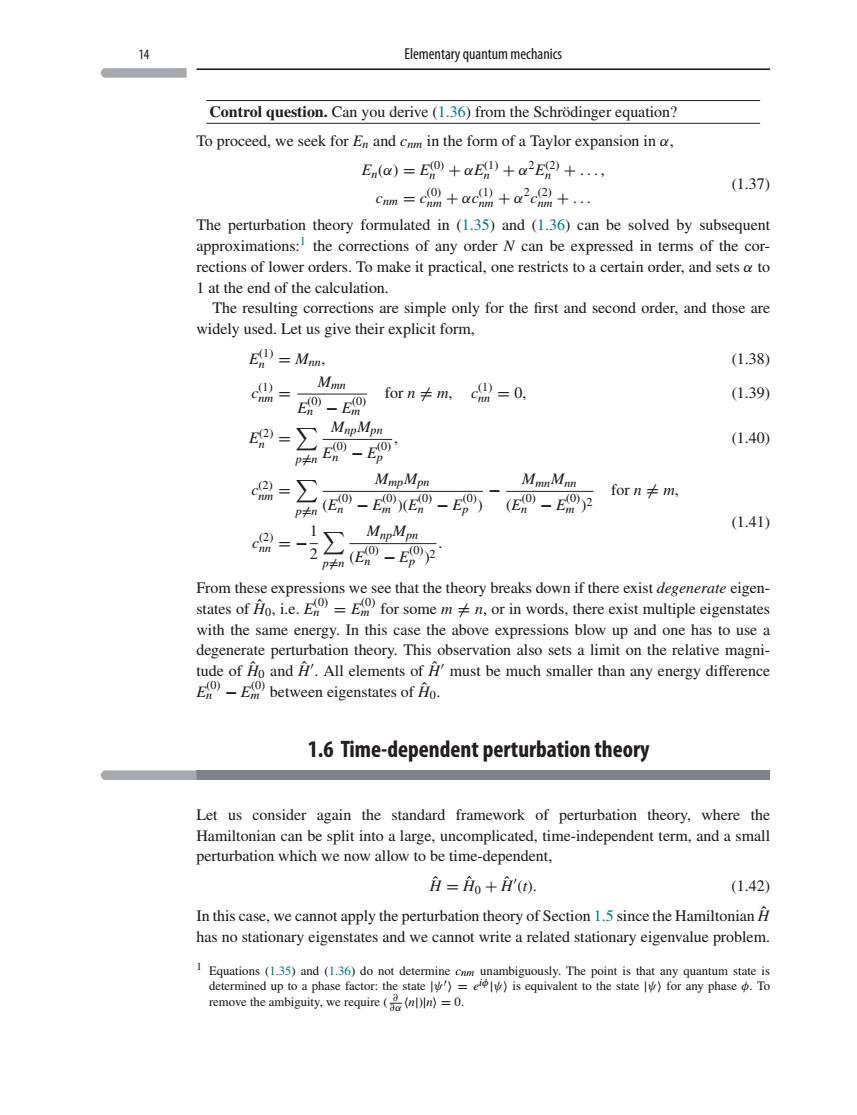正在加载图片...

4 Elementary quantum mechanics Control question.Can you derive(1.36)from the Schrodinger equation? To proceed,we seek for En and cm in the form of a Taylor expansion in En(a)=Et)+aEd)+a2)+.... (1.37) cmm =crom+acm+a.cm+.. The perturbation theory formulated in (1.35)and (1.36)can be solved by subsequent orrections of any order N can be expressed in terms of the cor- Tomake pracieal ne rerictonnd t I at the end of the calculation. The resulting corrections are simple only for the first and second order,and those are widely used.Let us give their explicit form. Ed Man (1.38) 出=E西a≠m=0 (1.39) (1.40) 品-乃 MmpMpn Mmn Mmn -0”-0-” forn≠m (1.41 鼎=∑ (E0-P with the same energy.In this case the above expressions blow up and one has to use a degenerate perturbation theory.This observation also sets a limit on the relative magni- tude of Ho and A'.All elements of A'must be much smaller than any energy difference E)-Ebetween eigenstates of Ao. 1.6 Time-dependent perturbation theory Let us consider again the standard framework of perturbation theory,where the Hamiltonian car be split into uncomplicate time-independent term,and a smal perturbation which we now allow to be time-dependent. 户=Ao+0). (1.42) In this case,we cannot apply the perturbation theory of Section 1.5 since the HamiltonianA has no stationary eigenstates and we cannot write a related stationary eigenvalue problem. remove the ambiguity.we require ()=0.14 Elementary quantum mechanics Control question. Can you derive (1.36) from the Schrödinger equation? To proceed, we seek for En and cnm in the form of a Taylor expansion in α, En(α) = E(0) n + αE(1) n + α2E(2) n + ... , cnm = c(0) nm + αc(1) nm + α2c(2) nm + ... (1.37) The perturbation theory formulated in (1.35) and (1.36) can be solved by subsequent approximations:1 the corrections of any order N can be expressed in terms of the corrections of lower orders. To make it practical, one restricts to a certain order, and sets α to 1 at the end of the calculation. The resulting corrections are simple only for the first and second order, and those are widely used. Let us give their explicit form, E(1) n = Mnn, (1.38) c(1) nm = Mmn E(0) n − E(0) m for n = m, c(1) nn = 0, (1.39) E(2) n = p=n MnpMpn E(0) n − E(0) p , (1.40) c(2) nm = p=n MmpMpn (E(0) n − E(0) m )(E(0) n − E(0) p ) − MmnMnn (E(0) n − E(0) m )2 for n = m, c(2) nn = −1 2 p=n MnpMpn (E(0) n − E(0) p )2 . (1.41) From these expressions we see that the theory breaks down if there exist degenerate eigenstates of Hˆ 0, i.e. E(0) n = E(0) m for some m = n, or in words, there exist multiple eigenstates with the same energy. In this case the above expressions blow up and one has to use a degenerate perturbation theory. This observation also sets a limit on the relative magnitude of Hˆ 0 and Hˆ . All elements of Hˆ must be much smaller than any energy difference E(0) n − E(0) m between eigenstates of Hˆ 0. 1.6 Time-dependent perturbation theory Let us consider again the standard framework of perturbation theory, where the Hamiltonian can be split into a large, uncomplicated, time-independent term, and a small perturbation which we now allow to be time-dependent, Hˆ = Hˆ 0 + Hˆ (t). (1.42) In this case, we cannot apply the perturbation theory of Section 1.5 since the Hamiltonian Hˆ has no stationary eigenstates and we cannot write a related stationary eigenvalue problem. 1 Equations (1.35) and (1.36) do not determine cnm unambiguously. The point is that any quantum state is determined up to a phase factor: the state |ψ = eiφ|ψ is equivalent to the state |ψ for any phase φ. To remove the ambiguity, we require ( ∂ ∂α n|)|n = 0